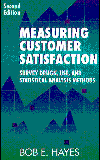Help
Desk & Support Center
Call Center
Management
Tech Support Resources
Project Management
Contact Center Technology
Online Support
Customer Satisfaction
Knock Your Socks Off
Service
Help Desk Institute
Telecom Books
Communication
Skills
Call Center Monitoring
Metrics & Benchmarking
CRM
Hiring, Training,
& Retention
Outbound Telebusiness
Novelties, Gifts, & Humor
Bargain Books (50% off)
Call
Center Courses
Telephony
Courses
ITIL
& Help Desk Courses
 |
Measuring Customer Satisfaction: Survey Design,
Use, and Statistical Analysis Methods, 2nd edition by Bob Hayes, hardcover, 278 pages, 1998, $35 |
The mysteries of every aspect of questionnaires dissolve as author Bob E. Hayes leads you systematically through the scientific methodology used to construct questionnaires. By using his guidelines, you will be able to:
- Pinpoint customer exceptions.
- Develop questions to measure whether you are meeting these expectations.
- Work toward meeting the Malcolm Baldridge National Quality Award (1990) customer satisfaction requirements.
- Evaluate the reliability and validity of any questionnaire.
- Use questionnaire data to monitor work processes, evaluate intervention programs.
- And more.
The book includes significant discussions of reliability statistics for measuring questionnaire precision, as well as the statistical framework for using satisfaction questionnaires.
Table of Contents
Chapter 1 - Introduction
- Model of customer satisfaction questionnaire development and use
Chapter 2 - Determining Customer Requirements
-
Quality dimension development
- Identification of quality dimensions
- Establishing specific examples of quality dimensions
- Software industry customer support example
- Generating critical incidents
- Quality of categorization process
- Comprehensiveness of the customer requirements
- Banking industry example
- Automobile industry example
- Statistical support
Chapter 3 - Reliability and Validity
-
The meaning of customer perception and attitude
- Reliability
- Classical measurement theory
- Types of error and reliability estimates
-
Benefits of scales with high reliability
- Detection of differences in satisfaction levels
- Detection of significant relationships between variables
-
Factors effecting reliability
- Number of items in the scale
- Sample of people
- The need for multiple items in measurement
-
Validity
- Content-related strategy
- Criterion-related strategy
- Construct-related strategy
Chapter 4 - Customer Satisfaction Questionnaire Construction: Item Generation, Response Format, and Item Selection
- Determining questions or items
-
Satisfaction items revisited
- Characteristics of good items
-
Response formats
- Checklist format
- Likert-type format
- Advantage of likert-type format
- Introductions to customer satisfaction questionnaires
-
Item selection
- Judgmental item selection
-
Mathematical item selection
- Item-total correlation
- Group differences
- Factor analysis
Chapter 5 - Sampling Methods
- Statistical sampling
-
Types of sampling: census, judgment, and statistical
- Census sampling
- Judgmental sampling
-
Statistical sampling
- Simple random sampling
- Stratified sampling
- Cluster sampling
-
Sample size and sampling error
- Sampling error
- Standard error of mean
- Calculating sample size
-
Random selection procedures
- Systematic selection with a random start
- Random number sampling
-
Response rates
- Establishing response rates
- Methods of increasing response rates of mail surveys
Chapter 6- Using Customer Satisfaction Questionnaires
-
Examples of customer satisfaction questionnaires
- Software quality
- Facilities department
- Banking industry
- Automobile industry
- Statistical support department
- Uses of customer satisfaction questionnaires
-
Summary indices
- Presentation of data
- Identify important customer requirements
-
Control charts
- Interpretation of the control chart
- Type of data
-
Control charts for attribute data
- The p chart
- The c chart
- Examples
-
Control charts for variable data
- The x and s charts
- Examples
- Organizational comparisons
-
Determine effectiveness of intervention programs
- Training programs
- Benchmarking
- Additional questions
Chapter 7 - Examples of Customer Satisfaction Questionnaires
-
Dental patient satisfaction
- Questionnaire development
- Sampling plan
- Survey administration
- Survey results
-
Factor analysis of the client satisfaction survey
- Correlation analysis
- Regression analysis
-
Reader survey
- Questionnaire development
- Administration of the survey
- Results
- Overall newspaper satisfaction score
-
Coffee shop
- Questionnaire development
- Administration of the survey
- Results
Appendix A: Critical incidents interview form
Appendix B: Satisfaction items and customer requirements form
Appendix C: Measurement scales
Appendix D: Frequencies, percentages, probabilities, histograms, and
distributions
Appendix E: Descriptive statistics
Appendix F: Statistics, parameters, and sampling distributions
Appendix G: Decision making and hypothesis testing
Appendix H: T-tests
Appendix I: Analysis of variance
Appendix J: Regression analysis
Appendix K: Factor analysis
Appendix L: Table of random numbers
Bibliography
Index